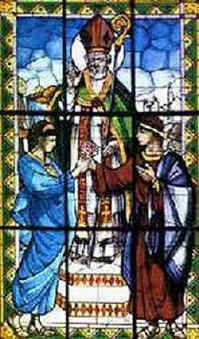Valentinus
Martyr
d. 14 February 312 (?)
 Through
the ages, many cultures have paused to celebrate love and romance in
mid-February. Few facts are known of St. Valentine, and what we
have is largely legend.
Through
the ages, many cultures have paused to celebrate love and romance in
mid-February. Few facts are known of St. Valentine, and what we
have is largely legend.
We may owe our observance of Valentine's Day to the Roman celebration of
Lupercalia, a festival that honoured Juno Februata, the goddess of
"feverish" (febris) love. Annually, on the ides of February,
love notes or "billets" would be drawn to partner men and
women for feasting and sexual game playing.
Early Christians frowned on these lascivious goings-on. In an attempt to
curb the erotic festivities, the Christian clergy encouraged celebrants
to substitute the names of saints. Then, for the next twelve months,
participants were to emulate the ideals represented by the particular
saint they'd chosen. Not too surprisingly, this version of Lupercalia
did not catch on, so instead this "feast of the flesh" was
turned into a "ritual for romance!"
This time, the Church selected a single saint to do battle the pagan
goddess Juno -- St. Valentine, whose actual name was Valentinus. He was
said to have demonstrated courage and valour in helping Christian
martyrs being persecuted under Emperor Claudius II in Rome, during a
time when giving any kind of aid to Christians was considered a crime.
According to one legend, Valentinus ignored a decree from Emperor
Claudius II that forbade all marriages and betrothals. Caught in the
act, Valentinus was imprisoned and sentenced to death for secretly
conducting several Christian wedding ceremonies.
He was beaten with clubs, stoned and finally
beheaded outside the Flaminian Gate. There is a legend that says while
awaiting his execution, he befriended his jailer's blind daughter whose
sight he restored to her. On
the eve of Valentinus' death, he is said to have written a farewell
message to the jailer's daughter and signed it, "From your
Valentine."
Despite the efforts of the Church, Valentine's Day continued to echo
Lupercalia in at least one respect - men and women, married or single,
would draw lots to select a "Valentine." Once paired, the
couple exchanged gifts and sometimes love tokens as well. They
would wear these names on their sleeves for one week. 'To wear your
heart on your sleeve' now means that it is easy for other people to know
how you are feeling.
The custom of lottery drawings to select Valentines persisted
well into the eighteenth century. Gradually, however, a shift took
place. No longer did both parties exchange gifts; instead, gift-giving
became solely the responsibility of the man!
This new twist helped to finally bring an end to the random drawing of
names, since many men were unhappy about giving gifts (sometimes very
costly) to women who were not of their choosing. And now that
individuals were free to select their own Valentine, the celebration
took on a new and much more serious meaning for couples!
The first written valentine is usually attributed to the imprisoned
Charles, Duke of Orleans. In 1415, Charles fought his lonely confinement
by writing romantic verses for his wife. By the sixteenth century
written valentines were so common that St. Francis de Sales, fearing for
the souls of his English flock, sermonized against them.
Manufactured cards, decorated with Cupids and hearts, appeared near the
end of the eighteenth century. A purchased valentine became the most
popular way to declare love during the early decades of the nineteenth
century. Miniature works of art, the cards were usually hand painted and
were often lavishly decorated with laces, silk or satin, flowers (made
from the feathers of tropical birds), glass filigrees, gold-leaf or even
perfumed sachets!
Acknowledgements:
Lovelore (no longer online),
Arcana
Celestia,
Valentine History
Image from Saint
Patrick's Church (no longer online)